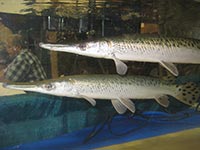The alligator gar (Atractosteus spatula)  is the largest member of Lepisosteidae, which includes 7 recognized species in 2 genera (Atractosteus and Lepisosteus), and is one of the largest freshwater fish species in North America. Capable of reaching 3 m in length and weighing 159 kg, the alligator gar is considered a living fossil, with fossil specimens dating back approximately 5 million years (Wiley, 1976; Echelle and Grande, 2014). Like all gars, the alligator gar has a long-bodied profile, often described as torpedo-shaped, a hard covering of interlocking, ganoid scales that serve as armor, a long snout filled with teeth, a swim-bladder modified to gulp and use atmospheric air to facilitate breathing in low-oxygen environments, and eggs that are toxic. A diagnostic feature of the genus Atractosteus is a double row of teeth on the underside of the upper jaw compared to a single row in Lepisosteus.
is the largest member of Lepisosteidae, which includes 7 recognized species in 2 genera (Atractosteus and Lepisosteus), and is one of the largest freshwater fish species in North America. Capable of reaching 3 m in length and weighing 159 kg, the alligator gar is considered a living fossil, with fossil specimens dating back approximately 5 million years (Wiley, 1976; Echelle and Grande, 2014). Like all gars, the alligator gar has a long-bodied profile, often described as torpedo-shaped, a hard covering of interlocking, ganoid scales that serve as armor, a long snout filled with teeth, a swim-bladder modified to gulp and use atmospheric air to facilitate breathing in low-oxygen environments, and eggs that are toxic. A diagnostic feature of the genus Atractosteus is a double row of teeth on the underside of the upper jaw compared to a single row in Lepisosteus.
The alligator gar originally occurred throughout the Mississippi River basin from Ohio to Louisiana and Gulf of Mexico tributaries of Mexico and southern U.S. states of Texas to Florida. However, its current distribution is much smaller due to commercial harvest and its early view by humans as a “trash fish” when it was targeted for eradication to improve sport fish populations. As a result, the alligator gar is considered vulnerable to extinction by the American Fisheries Society (Jelks at al., 2008), with its most secure populations in Louisiana and Texas (NatureServe, 2015).

Literature
DiBenedetto, K.C. 2009. Life history characteristics of Alligator Gar Atractosteus spatula in the Bayou Dularge area of southcentral Louisiana. Master’s thesis, Louisiana State University, Baton Rouge.
Echelle, A.A. and L. Grande. 2014. Lepisosteidae: Gars. Pages 243-278 In M.L. Warren, Jr. and B.M. Burr, editors. Freshwater Fishes of North America, Volume 1: Petromyzontidae to Catastomidae, Johns Hopkins University Press, Baltimore, Maryland.
Ferrara, A.M. 2001. Life-history strategy of Lepisosteidae: implications for the conservation and management of Alligator Gar. Doctoral Dissertation, Auburn, Alabama: Auburn University.
Inebnit III, T.E. 2009. Aspects of the reproductive and juvenile ecology of Alligator Gar in the Fourche Lafave River, Arkansas. Master’s thesis. University of Central Arkansas, Conway, Arkansas.
Jelks, H.L., S.J. Walsh, N.M. Burkhead, S. Contreras-Balderas, E.Díaz-Pardo, D.A. Hendrickson, J. Lyons, N.E. Mandrak, F. McCormick, J.S. Nelson, S.P. Platania, B.A. Porter, C.B. Renaud, J.J. Schmitter-Soto, E.B. Taylor, and M.L. Warren. 2008. Conservation status of imperiled North American freshwater and diadromous fishes. Fisheries 33: 372–407.
NatureServe. 2015. NatureServe Explorer: An online encyclopedia of life [web application]. Version 7.1. NatureServe, Arlington, Virginia. Available http://explorer.natureserve.org. (Accessed: July 8, 2015 ).
Wiley, E.O. 1976. The phylogeny and biogeography of fossil and recent gars (Actinopterygiii: Lepisosteidae). Miscellaneous Publication of the University of Kansas Museum of Natural History 64, Lawrence.
Wright, J.J., S.R. Davis, and T.J. Near. 2012. Gene trees, species trees, and morphology converge on a similar phylogeny of living gars (Actinopterygii: Holostei: Lepisosteidae), an ancient clade of ray-finned fishes. Molecular Phylogenetics and Evolution 63: 848-856.
Links
Atractosteus spatula page from the Florida Museum of Natural History
A. spatula page from the U.S. Fish & Wildlife Service's Warm Springs National Fish Hatchery
A. spatula page from the Alligator Gar Technical Committee


